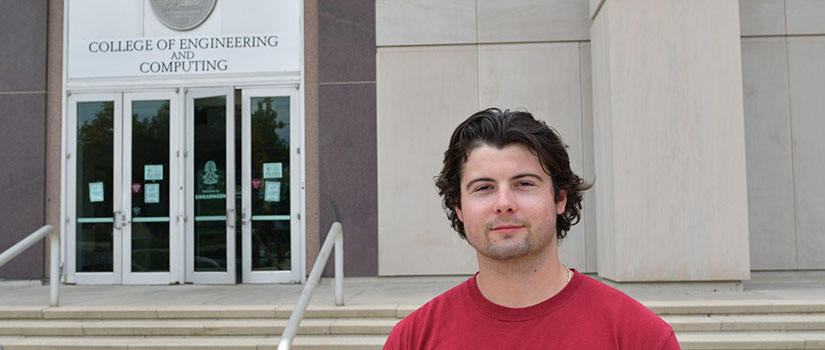As NASA missions become more advanced and complex, the amount of data and communications transmitted back to Earth will continue to increase. But this will also provide opportunities for developing more innovative applications.
Senior Electrical Engineering major Nick Wood completed a virtual internship this past summer through NASA’s Space Communications and Navigation (SCaN) office. His work to simulate cell phone interference with NASA’s radio frequency signals will aid the agency’s spacecraft communication testing procedures.
Wood described the internship, hosted by NASA’s Goddard Space Flight Center, as “very different from any other I’ve experienced.” With an interest in power electronics, Radio Frequency (RF) communications was not an area he had previously considered.
“It was really a shot in the dark,” Wood says. “It was a challenging interview - outside of my comfort zone. But the experience will make me a more well-rounded engineer coming out of college and changed my perspective on career paths moving forward.”
The internship’s stringent application process consisted of in-depth essay questions followed by a phone interview with NASA’s test team. Applicants may apply for up to 15 different projects, and Wood was granted an assignment with NASA’s RF Compatibility Testing Area (CTA).
The focus of the CTA is to test the connectivity and compatibility of spacecraft with NASA’s communication networks and ground stations, known as the Near Space Network. Wood’s task was to design and develop a cell phone tower radio frequency interference simulator to implement into their testing procedures and protocols.
Wood explained that the Near Space Network operates on the S band covering frequencies between two and four gigahertz. The problem facing NASA is that some Long-Term Evolution (LTE) cell towers operate on frequencies near two gigahertz, which can bleed over and interfere. “Due to FCC laws, the frequencies are not supposed to overlap, but there is some tolerance there,” Wood says. “But if NASA is trying to communicate with satellites, that cell phone interference needs to be managed.”
Wood created a simulated version of cell phone interference for the CTA using software defined radio, where components of a radio communication system traditionally implemented in hardware are instead implemented by computer software. He used two computers, one acting as a base station or cell tower transmitting and receiving signals, and the other running software emulating a cell phone user. The simulator provides real and accurate LTE signals and is used with the test setup that ensures communication is possible for spacecraft wishing to connect with the Near Space Network.
Electrical Engineering Associate Professor Enrico Santi recommended Wood for the internship. “Nick is an excellent student and part of my research group. I was very impressed with his summer internship. He worked in wireless communication, an area in which he had no background, and still was able to successfully complete the assignment. I attended online his final internship presentation, and he described very professionally his work.”
The internship was not without its challenges. Working virtually was difficult, as he had to locate someone on-site at NASA to troubleshoot equipment hardware. He was also presented with slim guidelines, which were no more than an idea on paper. “They said, ‘Here’s what we want the end result to be, and how you get there is up to you.’ It was kind of stressful, but the internship team at NASA made it very smooth,” Wood says.
Wood is deciding between a graduate program or seeking full-time employment and pursuing an MBA at a later date. Whatever course he takes, a management role in power electronics is the goal. “I’m a power electronics person,” Wood says. “I have always enjoyed aerospace and defense, and the NASA internship solidified that for me. My dream is to work in power electronics for aerospace or defense applications.”
SCaN serves as the program office for all of NASA’s space communications activities, including ground-based facilities and services and communications and navigation technology. The SCaN Internship Project (SIP) allows students to perform hands-on training with real mission scenarios, gain exposure and analyze powerful space communication systems, utilize network software tools and effectively communicate their findings in a final presentation to NASA management.
Wood holds many leadership positions within the college, including research assistant for the Navatek Digital Twin Project, funded by the Department of Defense, and peer mentor to first-year engineering students. He is also a College of Engineering and Computing Ambassador, leading tour groups for industry leaders and prospective students and representing the college at open house events and in promotional materials.
